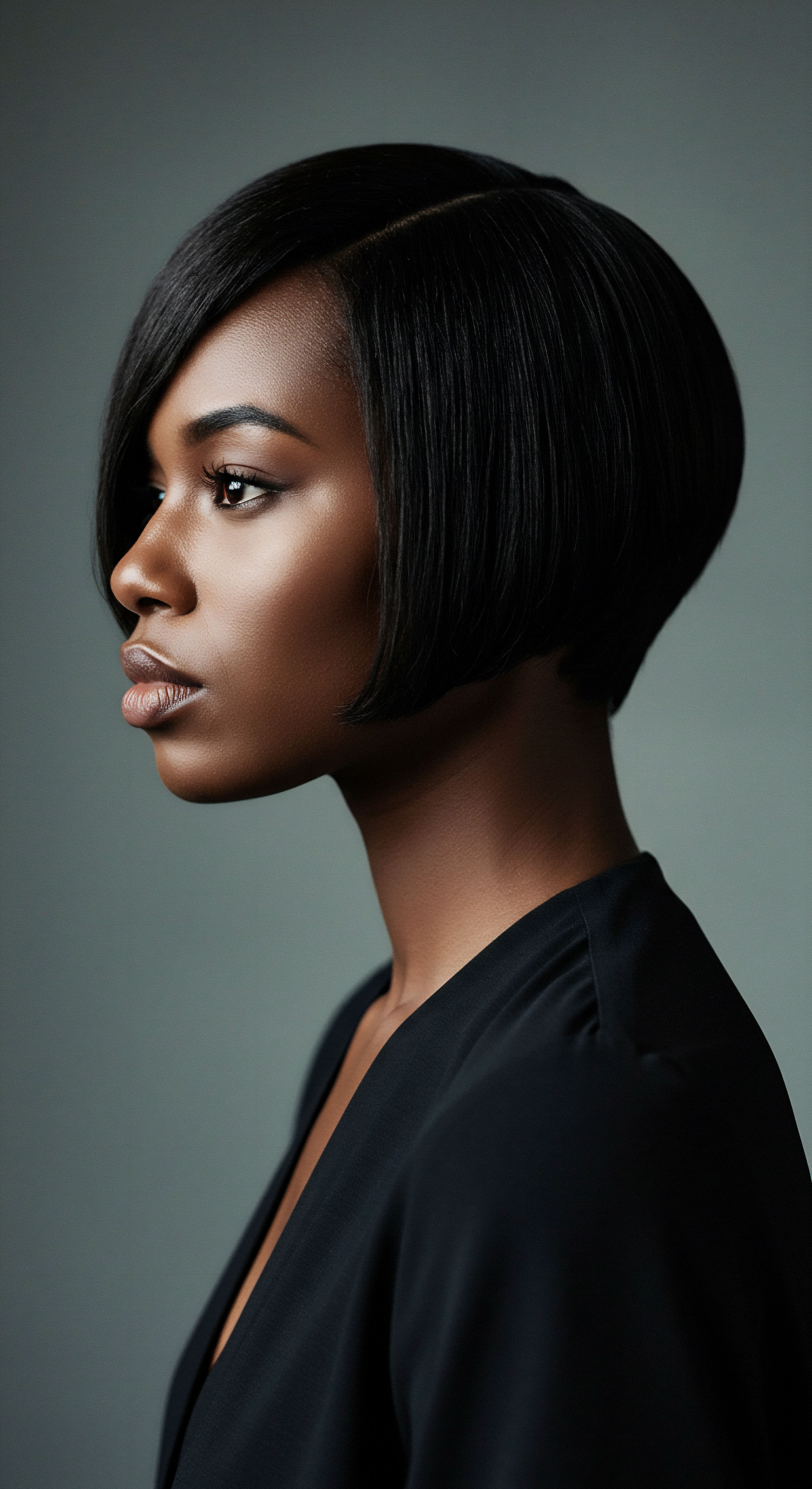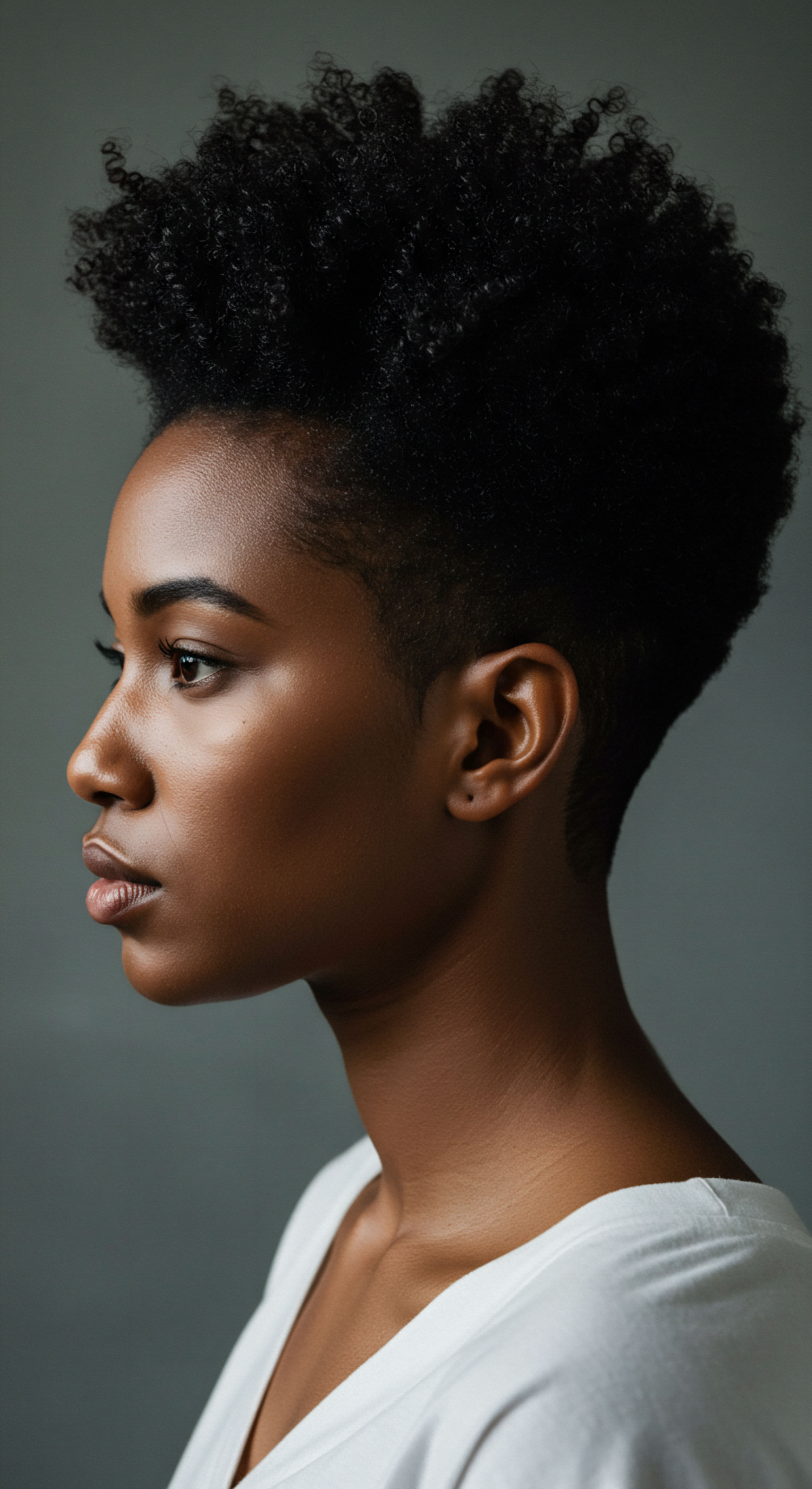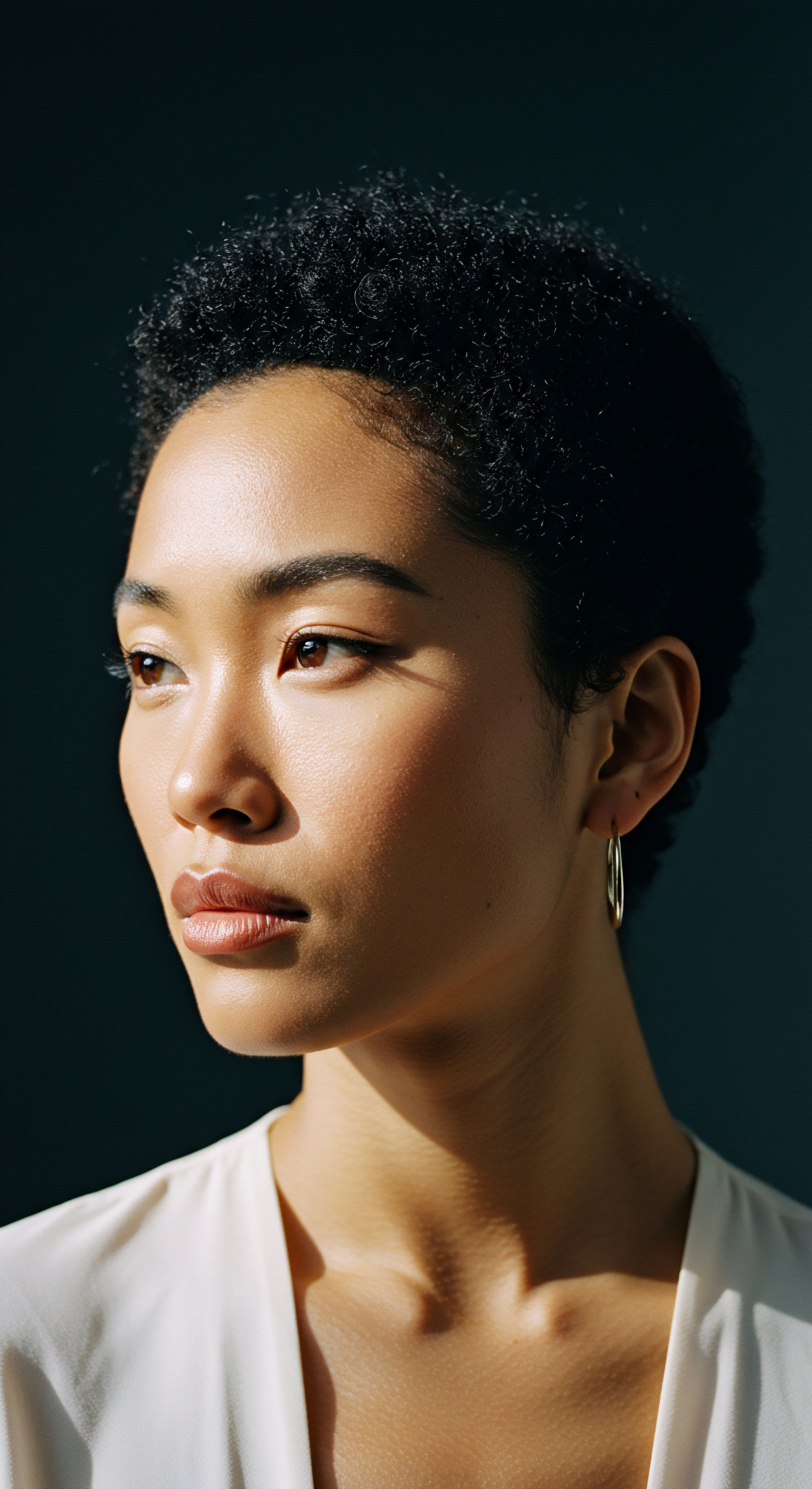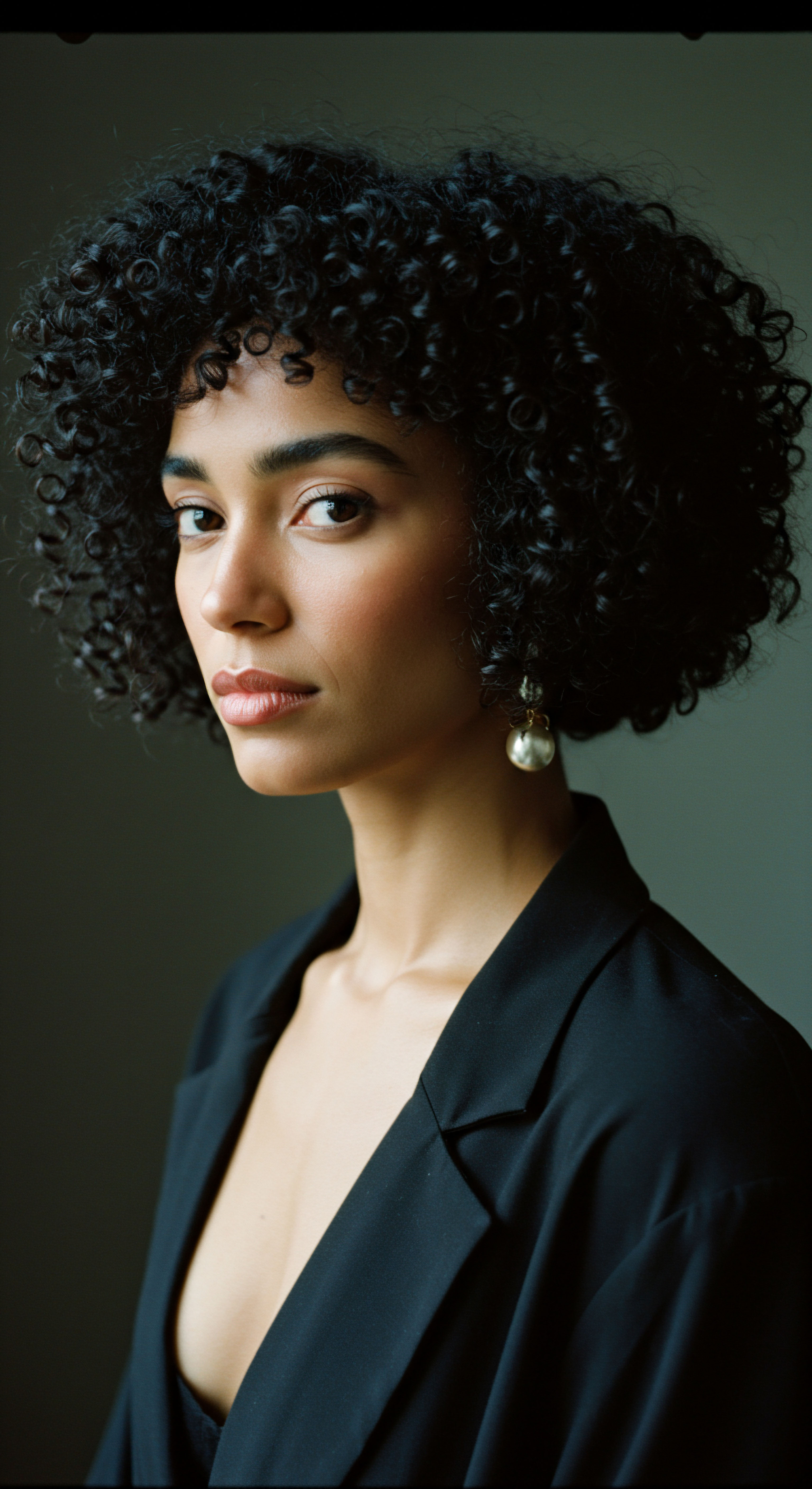
Roots
The very strands that crown our heads hold stories whispered across centuries, echoing with the rhythms of distant lands and the quiet wisdom of generations. They carry the essence of our forebears, a tangible connection to practices shaped by necessity, spirit, and environment. When we consider the care of our hair today, particularly textured hair, we are not merely engaging in a modern ritual; we are participating in a conversation that spans vast epochs, a dialogue between ancient ways and contemporary understanding. Each coil, kink, and wave bears the mark of this deep lineage, inviting us to look beyond the immediate and recognize the enduring power of historical traditions in shaping our present-day routines.

What Hair Meant to Early Civilizations
In many ancient societies, hair was far more than a simple adornment; it was a profound symbol, a visual language communicating status, identity, and even spiritual connection. For countless African communities before the era of forced displacement, hair styling was a complex system of identification, classification, and communication. It served as a medium through which people connected with the spiritual realm. Elaborate cornrows, intricate braiding, and delicate threading, often enhanced with accessories, were not just aesthetic choices.
They spoke volumes about a person’s tribal affiliation, marital status, age, wealth, and position within society. In some Nigerian communities, for instance, an “undone” appearance of a woman’s hair could signify depression, a lack of cleanliness, or even mental distress. This deep cultural weight underscores the profound respect and careful attention given to hair in these societies.
Similarly, among Indigenous peoples of North America, hair was considered a life force, a sacred source of identity and tradition. Long hair, for many tribes, represented a strong cultural identity, which in turn supported self-esteem, self-respect, a sense of belonging, and collective pride. Grooming practices were thus considered highly important, reflecting a respectful relationship with one’s self and community. Styles and ornamentation were guided by family and tribal values, acting as a form of creative expression that reaffirmed connections to family, tribe, and the natural world.
Hair in ancient societies was a powerful language, conveying identity, status, and spiritual connections through intricate styles and careful upkeep.

Ancient Hair Care Ingredients and Tools
The historical record reveals a rich palette of natural ingredients and ingenious tools used for hair care across different cultures. In Africa, natural butters, various herbs, and powders were commonly used to help hair retain moisture. Shea butter, coconut oil, and aloe vera, derived directly from local flora, served as nourishing and protective agents. These ingredients, still celebrated today for their conditioning properties, demonstrate an early understanding of hair’s needs.
Indigenous communities in North America also relied heavily on their natural surroundings. Yucca root was a frequent choice for cleansing, functioning as a natural shampoo and conditioner. Sage and cedar were applied for their soothing qualities on the scalp.
Beyond plant-based remedies, animal fats such as bear grease, raccoon fat, or deer marrow were popular pomades, offering conditioning and styling assistance. Some tribes even used buffalo dung or clay mixed with plant or mineral pigments to stiffen or color hair.
The Ancient Egyptians, known for their sophisticated beauty rituals, employed a fat-based substance as a styling gel to keep hair in place, both in life and, remarkably, in death. Analysis of mummified hair samples, some dating back 3,500 years, revealed coatings containing biological long-chain fatty acids like palmitic acid and stearic acid. This substance served as a styling product and a component of the mummification process, highlighting a desire for lasting beauty even beyond physical existence. They also used wigs extensively, and practiced full body hair removal using mixtures of wax, sugaring, lime powders, and grass wastes, alongside tools crafted from stone or bronze.
- Shea Butter ❉ Used in West African traditions for centuries to moisturize and protect hair from harsh environmental conditions, also recognized for supporting hair growth.
- Yucca Root ❉ A natural cleanser and conditioner favored by Indigenous tribes in North America.
- Amla ❉ Indian gooseberry, a staple in Ayurvedic hair care, used to strengthen hair, support growth, and maintain scalp health.
- Camellia Oil ❉ A traditional Japanese secret for shine, softness, and manageability, also providing protection from environmental stressors.

The Early Science of Hair Wellness
While not framed in modern scientific terms, many historical practices displayed an intuitive grasp of hair biology and scalp health. The use of oils and butters points to an early recognition of the need for moisture and lubrication, particularly for textured hair types prone to dryness. Scalp care rituals, often involving gentle massages and herbal treatments, aimed to stimulate blood flow and maintain a healthy environment for hair growth. This aligns with contemporary trichological principles that emphasize scalp health as the foundation of strong hair.
Ancient texts, such as a 3500-year-old papyrus from Ancient Egypt, even documented remedies for conditions like “bite hair loss,” likely referring to alopecia areata, demonstrating a long-standing human concern with hair loss and attempts to address it. This early interest in remedies, however rudimentary, speaks to a consistent human desire for healthy, abundant hair, a desire that continues to drive modern scientific inquiry into hair growth and scalp conditions.
The communal aspects of historical hair care, such as braiding circles in African cultures or mutual grooming among Native American families, also reveal a social science at play. These practices built community, transferred knowledge, and provided psychological comfort and belonging. The social dimension of hair care, often overlooked in a product-centric modern world, was a central element of well-being in historical contexts.
| Historical Tradition Using plant-based oils and butters for moisture |
| Region of Origin Africa, India, Morocco, Japan |
| Modern Parallel or Connection Popularity of natural oils (shea butter, argan, coconut) in contemporary conditioners, masks, and styling creams. |
| Historical Tradition Scalp massage with herbal infusions |
| Region of Origin Indigenous North America, India |
| Modern Parallel or Connection Emphasis on scalp health in modern trichology, use of essential oils and specialized scalp treatments. |
| Historical Tradition Intricate braiding and protective styles |
| Region of Origin Africa, Indigenous North America |
| Modern Parallel or Connection Continued use of braids, cornrows, and twists for protection and aesthetic in textured hair communities globally. |
| Historical Tradition Hair removal techniques (sugaring, waxing) |
| Region of Origin Ancient Egypt, Middle East |
| Modern Parallel or Connection Modern sugaring and waxing methods for hair removal, still using similar principles. |
| Historical Tradition These examples highlight the enduring wisdom of ancestral hair care. |

Ritual
Stepping from the quiet contemplation of hair’s deep roots, we find ourselves at the threshold of daily and periodic practices, the rituals that bring historical wisdom into lived experience. Hair care, at its core, is a sequence of actions, a dance between hands and strands, water and botanicals. Yet, these actions are rarely purely mechanical.
They are imbued with intention, connection, and a silent conversation between our present selves and the cumulative knowledge of those who came before. This section turns our gaze to how these actions, these rituals, have evolved, demonstrating a profound continuity even as the tools and contexts change.

How Do Daily Practices Reflect Ancestral Habits?
The rhythms of daily hair care, from cleansing to conditioning and styling, often mirror ancestral habits in surprising ways. Ancient Egyptians, for example, were meticulous about personal hygiene, including hair and scalp cleanliness. They washed and scented their hair, and wealthy individuals employed hairdressers. This early emphasis on cleanliness and pleasant scent echoes in our modern daily shampooing and conditioning.
Similarly, the widespread use of oils across diverse cultures for softening and protecting hair persists today. Shea butter, a staple in West African hair traditions, continues to be celebrated for its moisturizing and protective qualities against harsh environmental conditions.
Indigenous communities, too, engaged in daily grooming that held cultural weight. The act of braiding a child’s hair, for instance, was not just about neatness; it was a time of bonding, a quiet reinforcement of familial relationships. This communal aspect of hair care, where mothers, daughters, and friends gather to style hair, strengthens social ties and preserves cultural identity, a practice still observed in many communities today. The simple act of detangling or applying a balm becomes a moment of self-care, a gentle connection to the earth’s offerings, much as it was for those who used bear grease or yucca root centuries ago.

What Role Does Communal Care Play in Modern Hair Practices?
The communal nature of hair care, so prominent in historical settings, continues to shape modern practices, especially within textured hair communities. While formal “braiding circles” might be less common in urbanized settings, the spirit of shared knowledge and collective care remains. Online platforms, social media groups, and local salons often serve as contemporary gathering places where individuals exchange tips, product recommendations, and styling advice. This digital community reflects the historical act of learning and sharing within a group.
For Black women, hair styling, particularly braiding, was and remains a communal activity. This process strengthens bonds while preserving cultural identity. These shared experiences, whether in a salon chair or a virtual forum, provide support, affirmation, and a sense of belonging, mirroring the intergenerational transfer of knowledge that characterized historical traditions. The salon, for many, functions as a modern community hub, a place for connection and conversation beyond mere hair services.
Modern hair care, especially for textured hair, often reflects historical patterns of cleansing, oiling, and communal styling, transforming ancient wisdom into contemporary routines.

Are Modern Styling Techniques Rooted in Ancient Aesthetics?
Many contemporary styling techniques for textured hair find their conceptual origins in ancient aesthetics and methods. Styles like cornrows, Bantu knots, and various forms of braids have origins deeply embedded in African history. These protective styles, designed to safeguard strands from environmental damage and manipulation, were not merely decorative; they were practical and served a functional purpose, a principle that continues to guide modern protective styling.
Even the pursuit of straightened hair, while often influenced by Eurocentric beauty standards introduced during periods of colonialism and slavery, has historical parallels. Ancient Egyptians used heat and styling products to achieve certain looks, including straightened appearances. The hot comb, popularized by Madam C.J.
Walker in the late 19th and early 20th centuries, provided a means for Black women to straighten their hair, initially for conformity, but also as a path to economic independence within the hair care sector. This complex history demonstrates how even practices seemingly driven by external pressures can still connect to a long lineage of hair manipulation for diverse reasons, albeit with evolving motivations and consequences.
Modern hairstyling also draws from ancient techniques for ornamentation. Historical African hairstyles were often adorned with beads, cowrie shells, or intricate patterns, serving as important storytelling tools. Today, hair accessories, wraps, and extensions continue to allow for diverse self-expression, extending the tradition of hair as a canvas for personal and cultural statements.
- Cleansing Methods ❉ From ancient herbal washes to modern shampoos, the act of purifying the scalp and strands remains a core practice.
- Oiling Practices ❉ The application of natural oils for conditioning and scalp health, seen in various historical cultures, continues to be a central tenet of many contemporary routines.
- Protective Styling ❉ Techniques like braiding and twisting, originating in African and Indigenous traditions, are still fundamental for safeguarding textured hair from damage.

Relay
As we move from the foundational roots and the repetitive rituals, we arrive at the complex interplay, the “relay” of knowledge, cultural influence, and scientific discovery that truly connects historical hair care traditions with modern practices. This segment delves into the deeper currents that have shaped how hair is perceived, cared for, and even policed, revealing a story far richer and more layered than surface appearances suggest. It is here that science and society intersect, offering profound insights into the enduring legacy of the past on our present hair realities.

What Historical Societal Pressures Continue to Shape Hair Choices?
The legacy of colonialism and slavery casts a long shadow over modern hair practices, particularly for individuals of African descent. During periods of forced migration and subjugation, enslaved Africans were often stripped of their traditional hair tools and styles, their hair sometimes shaved or neglected as a means of control and cultural erasure. This forced assimilation initiated a painful historical trajectory where textured hair was devalued and stigmatized. Laws were even enacted in the 1800s in the United States to prohibit Black women from wearing their naturally coiled hair in public.
This historical prejudice led to the widespread adoption of straightening methods, like hot combs and chemical relaxers, which allowed Black individuals to conform to Eurocentric beauty standards for social acceptance and economic opportunity. Even today, the impact of these historical biases is evident. A 2020 study by researchers at Duke University’s Fuqua School of Business found that Black women with natural hairstyles, such as afros, twists, or braids, were often perceived as less professional than Black women with straightened hair, particularly in industries with conservative appearance norms.
This perception resulted in natural-haired Black women being less likely to receive job interviews. This persistent bias highlights how historical societal pressures continue to influence contemporary professional and social spheres, demonstrating a deep-seated cultural preference that has roots in discriminatory pasts.
The historical devaluation of textured hair, stemming from colonial practices, continues to affect perceptions of professionalism and beauty today.

How Do Ancient Remedies Inform Modern Hair Science?
The wisdom of ancient remedies, often dismissed as folklore, is increasingly finding validation through modern scientific inquiry, demonstrating a compelling convergence between traditional knowledge and contemporary understanding. Many plant-based ingredients used for centuries across Africa, Asia, and Indigenous communities are now recognized for their beneficial properties in hair and scalp care.
For example, ingredients like amla (Indian gooseberry), reetha (soapnuts), and bhringraj, long utilized in Ayurvedic practices for hair growth and scalp health, are now common components in modern herbal shampoos and treatments. Scientific research supports the efficacy of many of these botanicals, identifying active compounds that contribute to hair strength, scalp circulation, and anti-dandruff properties. This scientific corroboration transforms anecdotal evidence into evidence-based practice, closing the gap between ancient traditions and modern cosmetic chemistry.
The field of trichology, the scientific study of hair and scalp health, plays a central role in this modern interpretation of ancient wisdom. Trichologists investigate hair follicle biology, growth cycles, and scalp conditions, often integrating knowledge of nutrition and hormonal balance. This holistic approach aligns remarkably with historical practices that viewed hair health as an indicator of overall well-being. Modern trichology can, for example, assess how factors like stress, a recognized concern in historical wellness practices, can impact hair health and offer scientifically guided stress management techniques.

What Are the Health Implications of Modern Hair Care Products Compared to Historical Alternatives?
The transition from natural, plant-based historical hair care to modern chemical formulations has introduced new health considerations, some with concerning implications. While ancient remedies primarily relied on readily available botanicals and fats, modern products often contain synthetic compounds designed for specific effects like extreme straightening or coloring.
A significant area of concern lies with chemical hair relaxers, heavily marketed to and widely used by Black women to straighten curly or tightly coiled hair. These products are often loosely regulated and contain potentially harmful ingredients, including endocrine disruptors. A study by researchers at Boston University’s Black Women’s Health Study (BWHS) revealed a concerning association ❉ long-term use of chemical hair relaxers by postmenopausal Black women was linked to an increased risk of uterine cancer. Specifically, women who reported using hair relaxers more than twice a year or for over five years experienced a greater than 50% increased risk of uterine cancer compared to those who never or rarely used them.
This finding underscores a critical public health disparity, as Black women have higher rates of aggressive uterine cancer subtypes and are nearly twice as likely to die from the disease compared to non-Hispanic white women. The chemicals in these products, such as parabens, formaldehyde, bisphenol A, and metals, can be absorbed through the scalp, potentially linking them to these increased health risks.
| Aspect Primary Ingredients |
| Historical Approach (Examples) Natural butters, herbs, plant oils (shea, coconut, amla, yucca), animal fats, clay. |
| Modern Approach (Examples) Synthetic chemicals (sulfates, silicones, parabens, phthalates), processed oils, specialized polymers, some natural extracts. |
| Aspect Styling Methods |
| Historical Approach (Examples) Braiding, threading, twisting, natural air drying, use of heat from sun/fire. |
| Modern Approach (Examples) Chemical straightening (relaxers), heat styling (flat irons, curling irons), synthetic extensions, complex chemical treatments. |
| Aspect Health Implications |
| Historical Approach (Examples) Generally low systemic risk; potential for localized irritation from raw ingredients or improper application. |
| Modern Approach (Examples) Potential for chemical burns, hair breakage, and systemic health risks (e.g. uterine cancer from relaxers). |
| Aspect Knowledge Transmission |
| Historical Approach (Examples) Oral traditions, communal grooming, apprenticeship. |
| Modern Approach (Examples) Scientific research, media, social platforms, professional cosmetology schools. |
| Aspect The shift from natural ingredients to synthetic compounds highlights both progress and new health challenges. |
This stark contrast between historical reliance on natural compounds and the modern widespread use of synthetic chemicals prompts a deeper consideration of the long-term impacts of our beauty choices. While modern science offers precise diagnostics and targeted treatments for hair disorders, it also bears the responsibility of scrutinizing the safety of its innovations against the enduring wisdom of less invasive, nature-derived alternatives. The continued scrutiny of chemical relaxers, for instance, serves as a powerful reminder that progress must always be tempered with careful attention to holistic well-being.

Reflection
Our exploration into the historical traditions of hair care, set against the backdrop of modern practices, reveals a continuous human quest for beauty, health, and identity. From the ancient African villages where hair communicated status, to the Indigenous communities where it held spiritual weight, and the sophisticated rituals of Ancient Egypt, hair has always been more than just physical strands. It has served as a canvas for cultural expression, a marker of belonging, and a silent narrator of personal and collective stories. Today, while our tools and understanding have certainly advanced, the underlying desires remain remarkably consistent.
We still seek ways to nourish, protect, and style our hair, often returning to the very ingredients and principles that sustained our ancestors. The modern emphasis on natural ingredients, holistic scalp health, and culturally affirming styles represents a powerful echo of historical wisdom. Yet, this journey also reveals the enduring societal pressures and health challenges that have emerged, particularly for textured hair, underscoring the ongoing need for informed choices and a celebration of authentic beauty in all its forms.

References
- Bertrand, K. A. et al. (2023). Hair relaxer use and risk of uterine cancer in the Black Women’s Health Study. Environmental Research .
- Byrd, A. D. & Tharps, L. D. (2014). Hair Story ❉ Untangling the Roots of Black Hair in America. St. Martin’s Press.
- Fletcher, J. (1995). Ancient Egyptian Hair ❉ A Study of Its Production, Context, and Significance. University College London.
- Jacobs, L. & Kelemi, A. (2020). Natural hair chronicles of black female vloggers ❉ Influences on their psychological well-being. African Studies .
- McCreesh, N. et al. (2011). Ancient Egyptians used ‘hair gel’. Journal of Archaeological Science .
- Mbilishaka, A. M. & Clemons, C. (2024). Don’t Get It Twisted ❉ Untangling the Psychology of Hair Discrimination Within Black Communities. American Journal of Orthopsychiatry .
- Oforiwa, A. (2023). The History and Culture of African Natural Hair ❉ From Ancient Times to Modern Trends. AMAKA Studio .
- Patton, T. O. (2006). Hey Girl, Am I More Than My Hair? African American Women and Their Struggles with Beauty and Identity. Peter Lang.
- Rosette, A. S. & Koval, C. Z. (2020). The Natural Hair Bias in Job Recruitment. Social Psychological and Personality Science .
- Tan, C. S. & Chew, Y. L. (2023). Natural alternatives from your garden for hair care ❉ Revisiting the benefits of tropical herbs. Heliyon .